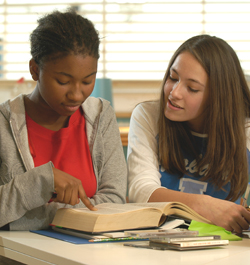Preparing your MYP learners for Spanish B

Expert IB educator and author, Cristóbal González Salgado, discusses this important transition in light of the new DP Spanish B syllabus
The MYP Spanish Language Acquisition course prepares students for the DP Spanish B course in many ways. When students reach the end of Year 5 of the MYP, their teachers can use their professional judgement to recommend them for either the Standard or Higher Level DP course. Generally speaking, students who have been working at Phase 4 (capable level) will be able to successfully progress to the DP Spanish B course (either Standard or Higher Level), and some strong students who have been working at Phase 2 or 3 level may also be eligible for the Standard Level course.
The MYP Spanish Language Acquisition course particularly prepares students for progression to the Diploma Programme in the following areas:
• Topics
• Concepts
• Language components and assessment
• Approaches to Learning (ATLs)
Topics
MYP topics are recommended by the IB in preparation for the eAssessment. These topics are contextualized by the six MYP global contexts and, crucially, are also aligned to the five prescribed themes that appear in new the DP guide: Identity, Experiences, Human Ingenuity, Social organization and Sharing the planet.
It is therefore easy to introduce these DP themes to MYP students – laying down the foundations for success in the Diploma course.
• Identities:
This DP theme can easily be introduced in the MYP classroom by designing units related to the MYP global context of “Identities and relationships”. For early phases, this could be explored through units about personal information, family and friends, or habits and routines. You could try building a unit around the question “Who are we?” – introducing topics about “health” or “healthy choices” as well, perhaps.
• Experiences:
This DP theme is connected to the MYP global context of “Orientation in space and time”, and can therefore be incorporated into units about exploring places. Great topics for this theme might be “travelling” or “customs and traditions” – giving students opportunities to discover new places or ways of living.
• Human Ingenuity:
This DP theme is related to human creativity, which we can in turn relate to the MYP global contexts of “Personal and cultural expression” and “Scientific and technical innovation”. We can prepare students for this theme by creating units about “creativity” (which is also one of our Language Acquisition Key Concepts!), “literary tales and legends as a means of expressing personal and cultural values”, or “the media and communication”. These topics provide a way for students to be creative and appreciate cultural values, as well as develop their critical thinking.
• Social organization:
This DP theme can be connected to the MYP global contexts of “Identities and relationships” and “Fairness and development”, and could be explored at MYP through units about students’ relationships at school or at home, or social networks. Specific topics to address, for example, might include bullying or family issues.
• Sharing the planet:
Lastly, this DP theme could be connected to the MYP global contexts of “Globalization and sustainability” and “Fairness and development”. This theme could of course be explored through a unit on the environment, but we could also consider other topics about respect for, and appreciation of, the diversity of mankind – for example, we could design units related to global issues such as Human Rights.
Designing MYP units and choosing texts that are related to the MYP global contexts allows us to make implicit connections to the prescribed DP themes. It is always good to keep these in mind when teaching our MYP students.
Concepts
The MYP key concepts (Communication, Connections, Creativity and Culture) and related concepts allow our students to deepen their conceptual understanding. When students understand the “big picture” of language concepts, this allows them to make interdisciplinary connections and build awareness of the authenticity of language tasks. Once students are following the DP course, they will become very familiar with the DP Language B concepts, which are:
• Audience
• Context
• Purpose
• Meaning
• Variation
I personally always have these DP concepts in mind when teaching MYP students, and aim to include activities in each unit that allow my students to become familiar with them.
A great way to think about the concepts is in relation to text conventions. The MYP Language Acquisition assessment criteria A and B require students to gain an understanding of text conventions via summative assessment tasks. However, we should also be working on this with our students through the activities and formative assessments that make up our units.
I also make students aware of these concepts by asking them inquiry (conceptual) questions when we work on different texts. These questions are also great questions to be asked in the MYP summative tasks (criteria A and B).
For instance:
• Who is the audience of this text?
• What is the register?
• What is the context of the text?
• What would change if the text were placed in another context?
• What is the text’s purpose?
• What does … mean?
• What does … mean if it were written/said in another context?
• What words does the author choose to achieve his/her purpose?
• How do you know who the author is?
• Imagine this text were written/said by another person from another place, how would it be different to its current form?
As you can see, these questions are clearly connected to our MYP related concepts. When designing our units, we need to keep the key and related concepts that we’ve chosen in mind, and make sure that these are represented in the summative assessment tasks at the end of each unit. When working on our MYP Spanish Language Acquisition Student Books, this was something we had at the forefront of our minds. We ensured that the concepts were aligned to units and activities so that, through inquiry, students could reflect on, and understand, the application of the tasks to real-life communication.
Language components and assessment
The DP Language B assessment components are also aligned to the MYP assessment criteria and objectives.
• The DP Paper 1 is focused on written communication. In the MYP, we should also encourage our students to produce written work in an authentic way, recognising variations between different text types. In particular, I would advise exploring the differences between personal, professional and media texts with MYP students. In both DP and MYP writing tasks, concepts are embedded in the assessment criteria.
• The DP Paper 2 tests students’ receptive skills (reading and listening). Reading and listening comprehension is also tested in the MYP assessment criteria A and B, and text handling activities are also assessed, with teachers encouraged to design tasks made up of varied comprehension activities, just like in the DP. As part of multimodality, it is good practice to use audio-visual texts for assessment in the MYP (assessment criterion A), as we should encourage our students to understand and explore spoken texts in real-life, authentic contexts. That said, the DP listening comprehension assessment does not involve a visual component.
• The DP Internal Assessment examines speaking skills. Speaking tasks are also a compulsory component of the MYP. The fact that the DP Standard Level speaking task is a response to a visual stimulus also aligns very well with the MYP since students should also be prompted to respond to a multimodal text as well. The DP Higher Level speaking task is in response to a literary text and we should be working with literary texts also in the MYP. I personally use some student-friendly literature in the capable and proficient levels as an excellent way of learning language and appreciating the target Spanish cultures.
Approaches to Learning
The ATL skills are consistent across both programmes:
• Thinking skills
• Communications skills
• Social skills
• Self-management skills
• Research skills
When designing our MYP units, we should incorporate all ATL skills so that students will be very familiar with them by the time they reach the end of the MYP, and incorporating the right ATL into an activity or unit will help to make these more coherent and meaningful to our students. In the DP, we must also make connections to Theory of Knowledge (TOK), and in the MYP we should be developing critical and creative skills under the umbrella of conceptual understanding. As a result, the transition between both programmes should run very smoothly.
I always aim to ignite students’ inquiry and curiosity by exposing them to interesting and appealing texts and topics. If we do this, students will be engaged in class and drive the learning process themselves. As an advocate for student-centred teaching and learning, I believe that students will be successful in their learning of a second or third language if we let them act and do. And, as a teacher, I feel my role is to guide them to achieving success.
|
|
By Cristóbal González Salgado Cristóbal González Salgado is an experienced teacher of MYP and DP Spanish and Theory of Knowledge. He is also an established IB workshop leader, examiner and moderator, and collaborated on the development of the new MYP Language Acquisition guide. He is co-author of Oxford’s MYP Spanish Language Acquisition resources. |
More support
Secure MYP Spanish language foundations
Build the foundation learners need for DP. Develop understanding in phases 1 and 2, and drive achievement in phases 3 and 4.
Search results
No results were found© 2024 Oxford University Press. All rights reserved.



